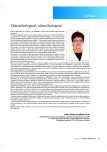The nutrition and intensive metabolic care and COVID-19 infection (SARS-CoV-2)
Authors:
prof. MUDr. Zdeněk Zadák, CSc. 1,2; MUDr. Radomír Hyšpler, Ph.D. 2; RNDr. Mgr. Alena Tichá, Ph.D. 2
Authors‘ workplace:
Centrum pro výzkum a vývoj, FN Hradec Králové
1; Ústav klinické biochemie a diagnostiky, FN Hradec Králové
2
Published in:
Geriatrie a Gerontologie 2020, 9, č. 2: 66-72
Category:
Overview
Resistance to bacterial and viral infections is significantly dependent on the nutritional and immunological status of the individual. Due to the fact that malnutrition and starvation have a strong immunosuppressive effect and the incidence of malnutrition and thus the incidence of immunodeficiency increases with age, it is evident that coronavirus infection is most acutely at risk for older age groups. In addition to preventive measures and vaccination, nutritional support is a powerful tool in the fight against the spread and consequences of the disease. Another important aspect is the nutritional support of critically ill patients, especially on artificial lung ventilation (UPV), where nutritional support is inevitable. Another way to use artificial nutrition is to application of pharmaconutrients such as MCT and n-3 fatty acids, which give hope for reducing the late consequences of coronavirus infection, the most serious of which is subsequent pulmonary fibrosis (1, 2). The article draws attention to the possibilities of metabolic and nutritional aspects in the treatment of COVID-19 and briefly provides and comments on an overview of the recommendations of the European Society of Parenteral Nutrition (ESPEN) and the American Society of Parenteral and Enteral Nutrition (ASPEN).
Keywords:
enteral nutrition – Immunity – coronavirus – SARS CoV 2 – COVID 19 – parenteral nutrition – critical care – malnutrition
Sources
1. Conti P, Gallenga CE, Tete G, Caraffa A, Ronconi G, Younes A, Toniato E, Ross R, Kritas SK. How to reduce the likelihood of coronavirus-19 (CoV-19 or SARS-CoV-2) infection and lung inflammation mediated by IL-1. J Biol Regul Homeost Agents, 2020, 34(2), doi: 10.23812/Editorial-Conti-2.
2. Wang J, Wang BJ, Yang JC, Wang MY, Chen C, Luo GX, He WF. Advances in the Research of mechanism of pulmonary fibrosis induced by Corona Virus Disease 2019 and the corresponding therapeutic measures. Zhonghua Shao Shang Za Zhi, 2020, 36, doi: 10.3760/cma.j.cn501120-20200307-00132.
3. Culebras JM. Malnutrition in the Twenty-First Century: An Epidemic Affecting Surgical Outcome. Surgical Infections, 2013, 14(3), doi: 10.1089/sur.2013.9993, 237-243.
4. Imoberdorf R, Meier R, Krebs P, Hangartner PJ, Hess B, Stäubli M, Wegmann D, Rühlin M, Ballmer PE. Prevalence of undernutrition on admission to Swiss hospitals. Clinical Nutrition, 2010, 29, 38-41.
5. Donini LM, Scardella P, Piombo L, Neri B, Asprino R, Proietti AR, Carcaterra S, Cava E, Cataldi S, Cucinotta D, Di Bella G, Barbagallo M, Morrone, A. Malnutrition in elderly: social and economic determinants. The Journal of Nutrition, Health & Aging, 2013, 17(1), 9-15.
6. Barazzoni R, et al. ESPEN expert statements and practical guidance for nutritional management of individuals with SARS-CoV-2 infection. Clinical Nutrition, 2020, https://doi.org/10.1016/j.clnu.2020.03.022.
7. Reyes L, Arvelo W, Estevez A, Gray J, Moir JC, Gordillo B, et al. Population-based surveillance for 2009 pandemic influenza A (H1N1) virus in Guatemala, 2009. Influenza Other Respir Viruses, 2010, 4, 129-140.
8. Zadák Z. Výživa v intenzivní péči. 2. rozšíř. aktual. vyd. Praha: Grada Publishing, 2008.
9. Papadimitriou-Olivgeris M, Gkikopoulos N, Wüst M, Ballif A, Simonin V, Maulini M, et al. Predictors of mortality of influenza virus infections in a Swiss Hospital during four influenza seasons: role of quick sequential organ failure assessment. Eur J Intern Med, 2019, 19, 30460-30461.
Podpořeno MZ ČR – RVO (FNHK, 00179906).
Labels
Geriatrics General practitioner for adults Orthopaedic prosthetics Hygiene and epidemiology Medical virology Clinical microbiologyArticle was published in
Geriatrics and Gerontology

2020 Issue 2
- Metamizole vs. Tramadol in Postoperative Analgesia
- Metamizole at a Glance and in Practice – Effective Non-Opioid Analgesic for All Ages
- Memantine in Dementia Therapy – Current Findings and Possible Future Applications
- What Effect Can Be Expected from Limosilactobacillus reuteri in Mucositis and Peri-Implantitis?
- Memantine Eases Daily Life for Patients and Caregivers
Most read in this issue
- Frail patients in long term care institutions
- Coronavirus infection within senior people – The immunologist’s view
- Influence of selected factors on evalution of dignity of older person
- Risks of treatment by dabigatran in seniors with chronic kidney desease
